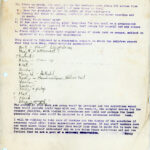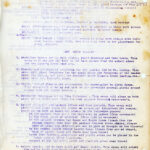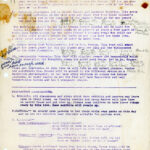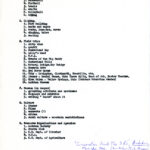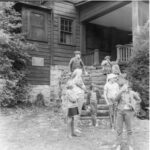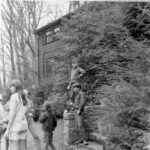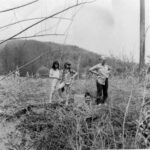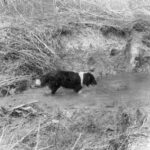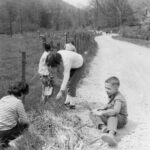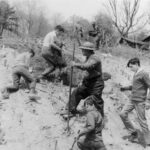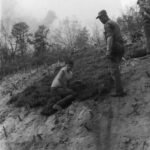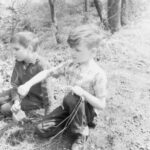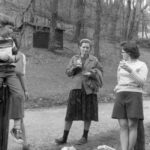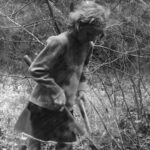Pine Mountain Settlement School
Series 09: BIOGRAPHY – Staff
Series 13: EDUCATION
Loren W. Kramer
1970 First Earth Day
at Pine Mountain Settlement School
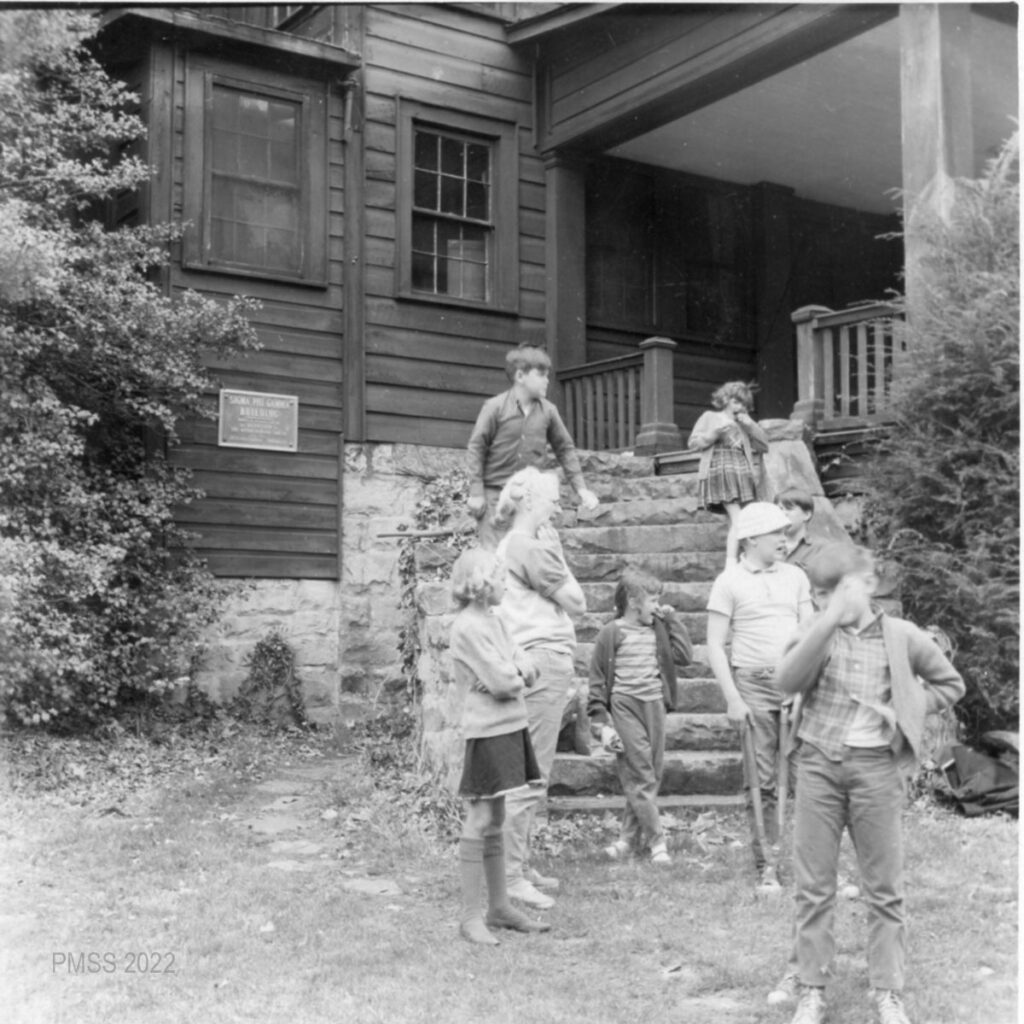
001 Mary Rogers and group of school children on Pine Mountain’s first EARTH DAY, April 1970. [Kramer_loren_earth_day_001 ]
TAGS: Loren W. Kramer, Loren Kramer, first Earth Day at Pine Mountain Settlement School, 1970, Community School, environmental education, educational planning, outdoor classroom, Outdoor Education planning, lesson plans, environmental awareness, conservation, pollution
LOREN W. KRAMER 1970 First Earth Day
at Pine Mountain Settlement School
TRANSCRIPTION
FIRST EARTH DAY AT PINE MOUNTAIN SETTLEMENT
APRIL 22, 1970
[By Nancy Sather]
April 22 is a nationwide day for environmental, conservation, and ecology teach-ins throughout the country. The President of the USA has asked the teachers in our high schools and our elementary schools to give special emphasis to this Day. The whole New York City school system has been asked to teach the children about pollution and conservation on this day. Here are some suggestions of things we could do in this school to prepare for and to observe this nationwide learning day.
TO PREPARE FOR IT:
Place special emphasis on outdoor studies especially conservation, ecology, and the balance of nature in our April science classes.
Conduct either room or school side poster contests o wise use of resources major causes of pollution, how we can stop pollution: air pollution, water pollution, garbage problems.
Make collections of newspaper Weekly Reader, and magazine clippings that discuss the problems of conservation, use of natural resources and pollution.
Make charts and graphs with nationwide or local statistics about kinds of waste, trash on campus (what percentage is paper cans, cigarette butts, etc!), or other pertinent graphs.
Write stories and essays about conservation [and] different types of pollution, natural resources, etc.
TO OBSERVE THE DAY:
- Ask our conservation officer to visit the school and talk to the classes.
- Show one or several good films about land use conservation etc We have several here now for all age levels and will also have one from the conservation office and one from the Audubon society at that time.
- Have an outdoor field day complete with an outdoor lunch
- Give each child an opportunity to learn about the
quail project and to observe the quail, especially the younger ones who may not have done so, - Ask staff members who have been involved in various types of conservation work to share their experiences with the children.. Specifically:
Vernon [Conley] – conservation work, fish and game club activities.
Brit [Wilder] – Soil conservation activities.
Alvin [Boggs] – How we test creek water for acidity, and its relationship to strip mining. - Display the posters, charts, etc, and any other displays which might be made by the scouts, pre-scouts, various rooms, and other clubs. Collections, a soil profile, science projects, etc.
- INVOLVE the children in an afternoon of environmental activities. They would be divided into several “teams” of families, each of which would have children of various ages so that the older children could feel more responsible.) Hopefully, we would be able to involve not only the teachers but some of the other staff and perhaps some community parents. Activities might include:
A. stabilizing the bank above the Isaac’s Creek road with sticks and crown vetch under the supervision of Brit.
B. Relabeling or making a new nature trail.
C. Dividing and re-planting clumps of daffodils under the supervision of Mary Rogers.
D. Cut off bittersweet which is strangling trees (with approval of maintenance and Mr. [Burton] Rogers).
E. Repaint and straighten up the picnic grounds owned by the Community Council.
F. Compost pile.
G. Clean up trash, tin cans, etc in the roadside area along 221 across from our dump (across the creek) and take trash to dump.
H. Save for roadside in the direction of Jess Patterson‘s.
I. Plant willow cuttings along exposed areas of creek bank on campus subject to approval of Mr. Rogers and maintenance.
This should be followed by a discussion session in which the children report what they have done. Other activity suggestions?
Brit — plant lespedeza
Mary R.— bittersweet
Burton R. —
Alvin — clean up
Matt —
Sandra —
Mary W. — daffodil
Nancy S. — Nature Trail
Vernon C. —
Loren —
Milly — Photog.
Mae — ?
Maud — ?
Edna
Toppy — [?]
The amount of time each age group would be involved and the activities which they would include could vary with age, for example, the simpler movies for the younger children, with visits to greenhouse and quail ad perhaps the least physically able ones could be assigned to a less strenuous outdoor task.
I will be willing to take care of working out the timing of the schedules if everyone would offer their suggestions and comments. If any staff members have any work along these lines that they would like done it might fit in here too, The children should understand why we are doing these activities and get the feeling that we are a part of a national observance.
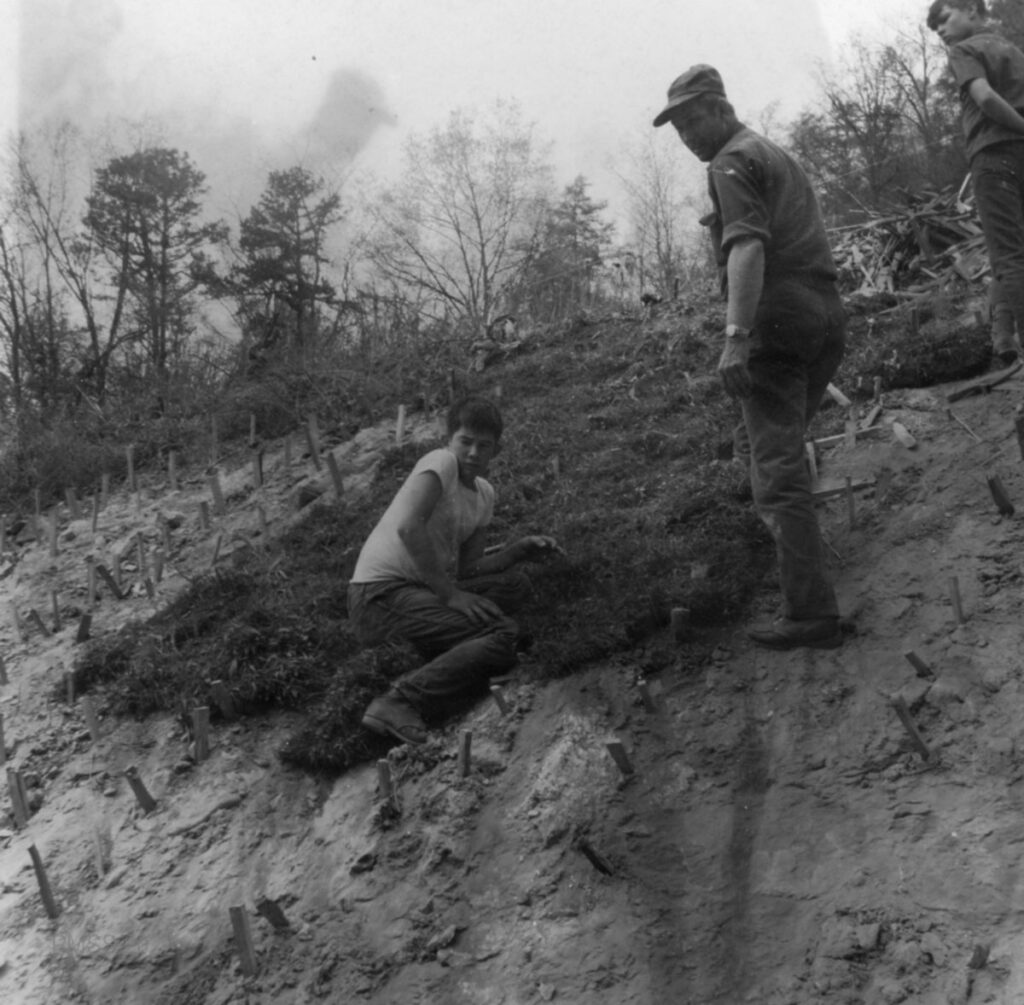
007 Student and staff stabilizing bank with turf. [kramer_loren_earth_day_007]
SCHEDULE FOR EARTH DAY
April 22 [1970]
(If it rains on April 22, April 23)
10:00 AM Animal film for all ages. Conversation Club.
10:30 Talk by Vernon Conley about Fish and Game Club activities for all ages.
Break for looking at exhibits and bathroom.
Kindergarten and first and second grades leave
to visit quail (beehives and ?
10:40 Film “Conservation for Beginners” followed by discussions (brief)
Soil Conservation — Brit Wilder
Water testing — Alvin Boggs
Film “Look to the Land”
After film break for bathroom, looking at exhibits, hand washing.
11:30 LUNCH – Outdoors the children will be assigned to their work groups during this time and eat together in these groups,
12:00-12:15 Break for bathroom, etc.
12:15 Work begins. Children will remain in their workgroups with their work leaders until 2:30, when they will meet on the playground for group pictures.
WORKGROUP LEADERS
- Stabilize bank — led by Brit Wilder, Asbel Browning, and Omer Lewis. This group will lay and pin turf to the bank across from the school along the new Isaac’s Creek readout. (names of students)
- Cleanup and planting of lespedeza ** for the quail — led by Mr. Conley. This group will plant lespedeza for the quail along the fence rows of the meadow below the chapel, and clean the roadside along Isaac’s Creek, leading the trash into Mr. Conley’s truck.
- Picnic ground cleanup and preparation for summer — Led by Alvin Boggs. This group will clean up and work on the community council picnic ground across from the school grounds.
- Creekside cleanup — led by Edna Patterson. This group will clean up both sides of the creek bank from the West pasture through Patterson’s.
- Campus cleanup — led by Mary Wilson and Frank Cornett. This group will clean up all trash along the creeks and campus and throughout the campus. Trash can be left in boxes for pickup in the following places:
—In the pasture near where the machinery is parked (from creekside)
— by the front porch of Westwind (from hill by Westwind)
—in the carport between Far House and Zande House (trash from the branch running down into the pasture between these places Please make it clear the children are not to pick or trample on the flowers)
—- by the wooden garage behind Laurel House and woods near Open House)
—-trash from Burkham, playground, and picnic area can be placed in the trash cans at these locations,
—-carport at Old Log (from creek and roadside areas near there)
6. Nature trail — led by Matt Boggs and Nancy Sather. This group will re-level the nature trail from Uncle Williams Cabin to the pot shop and around a loop behind the rocks near Open House. They will also remove all dead brush from these trails placing it well away in the woods. If there is time the trail behind Draper up toward Conley’s will also be relabeled.
7. Daffodil planting — led by Milly Mahoney and Maude Wilder. This group will dig up daffodils from the area between the library and Big Log (farthest back thick row) and replant them in small holes in a row from the swimming pool toward Laurel House on the side toward the branch. (If the job runs out they can also be planted in a row along the lower side of the North lawn of Far House.)
8. Daffodil planting — led by Sandra Hansel and Lorraine Browning. This group will get daffodils in the same area and plant them from Uncle William’s cabin in a row on the roadside of the pasture fence as far out toward the gate as you can get.
The daffodils should be dug up in clumps (being careful not to split the bulbs) and divided into single bulbs to be planted at least a foot apart in holes just large enough for the bulbs (about 3 inches deep) One child can dig holes while another sticks the bulb in and then they can trade jobs. A child could carry a large can of water to water them.
9. Saving trees from bittersweet — led by Mrs. [Mary] Rogers. This team will start at the creek above the Big Log lean to area and clip all the bittersweet in the Pine Plantation.
10. Honeysuckle resolve — This team will clip and remove the honeysuckle which is strangling the forsythia along the north pool fence. Led by Mr. Kramer.
Final get-together — At this time we will take an all-school picture. During the activities, Mrs. [Atossa] Kramer will be around to the different groups as a wandering photographer. We may have other visitors on campus too –taking pictures. We might expect to see the Fish and Game Department and Soil Conservation Agents and local newspaper people.
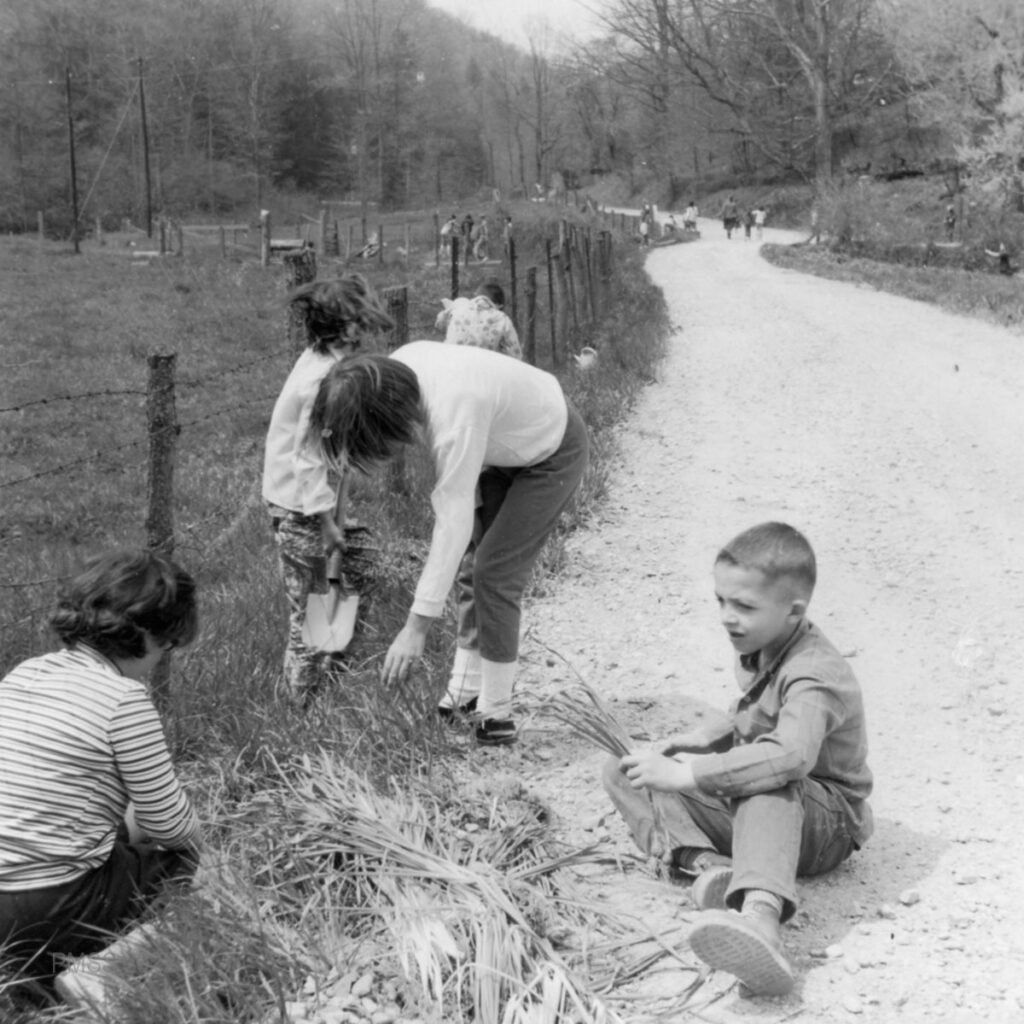
005 Planting lespedeza [?] or possibly transplanting daffodils [?] along the fence row. [kramer_loren_earth_day_005]
PREPARATORY ARRANGEMENTS
- EXHIBITS: All classrooms and clubs which have exhibits and posters may leave them in their rooms on Tuesday evening and Nancy Sather will take them to Laurel House and put them up. Please urge children to have these things ready by this time. Some exhibits will remain up.
- CLOTHING: We should urge parents to let their girls wear pants on this day and to let the children wear clothing suitable for outdoor work.
- EQUIPMENT: Bank Stabilization — Turf (maintenance)
Pegs — will be made by work boys in advance)
Truck will be used to move the turf
Cleanup and lespedeza — Mr. Conley’s truck
Lespedeza seed (Mr. Conley will get it)
Hoes or dibble sticks or other tools??
Cleanup —-large cardboard boxes from Laurel House. (These boxes will be picked up in advance and waiting for you in the Draper Middle room.
Creekside cleanup —- boxes will be delivered to Edna [Patterson]
Nature Trail —-labels
Marking pen
Tree books [for identification]
Bittersweet and Honeysuckle —-clippers —-Maintenance ???
Daffodil planting —- trowels from Conleys (?), Mrs. Rogers, Maud Wilder, ??
NOTES ON REVERSE OF LAST PAGE.
GALLERY: 1970 First Earth Day at Pine Mountain Settlement School
EARTH DAY PLANNING
- 001-1 kramer_loren_earth_day_001
- 002-1 kramer_loren_earth_day_002
- 003-1 kramer_loren_earth_day_003
- 004-1 kramer_loren_earth_day_004
- 005-1 kramer_loren_earth_day_005
- 006-1 kramer_loren_earth_day_006
EARLY OUTDOOR EDUCATION PLANNING DOCUMENTS
TRANSCRIPTION: Image 03 [See Gallery Below]
[In an early October 1969 document, Kramer explains the sources of his thoughts regarding the development of an Outdoor Education program at Pine Mountain Settlement School.]
This outline is briefly presenting an idea that came to me soon after I came to Pine Mountain, regarding a future direction of educational program the Settlement might take. It could be a program which would
a) lead in a relevant educational field
b) make use of its unique campus resources, facilities, and the talents of its long-time staff, and
c) provide an educational opportunity for the local community, but also the broader community of neighboring counties and Eastern Kentucky in general.I was first introduced to the formal concept of Outdoor Education when I was in Yellow Springs, Ohio and I became acquainted with the Antioch College program. Antioch’s program is in full force only during the summer months, with its residential and camping program. But, as I thought more about the Pine Mountain situation and especially when I read about the year-round program offered in the Ann Arbor Michigan public school system, (Conservation Joins the 3 R’s, Audubon, March 1966), I realized that my outline should be revised and expanded to accommodate a year-round program for Pine Mountain.
— Loren W. Kramer
GALLERY: Early Outdoor Education Planning Documents
[NOTE: For the full transcription of images 01 and 02 go to LOREN W. KRAMER Education Planning with Toppy.]
- 01 kramer_l_edu_outdoor_planning_001
- 02 kramer_l_edu_outdoor_planning_002
- 03 kramer_l_edu_outdoor_planning_003
GALLERY: LOREN W. KRAMER 1970 First Earth Day
at Pine Mountain Settlement School
- 001 kramer_loren_earth_day_001
- 002 kramer_loren_earth_day_002
- 003 kramer_loren_earth_day_003
- 004 kramer_loren_earth_day_004
- 005 kramer_loren_earth_day_005
- 006 kramer_loren_earth_day_006
- 007 kramer_loren_earth_day_007
- 008 kramer_loren_earth_day_008
- 009 kramer_loren_earth_day_009
- 010 kramer_loren_earth_day_010
- 011 kramer_loren_earth_day_011
SEE ALSO
LOREN W. KRAMER Staff – Biography
LOREN W. KRAMER Correspondence Guide and Acquisition List
DANCING IN THE CABBAGE PATCH Earth Day and Mary Rogers
MARY ROGERS Uncle William’s Mandate to Pine Mountain


